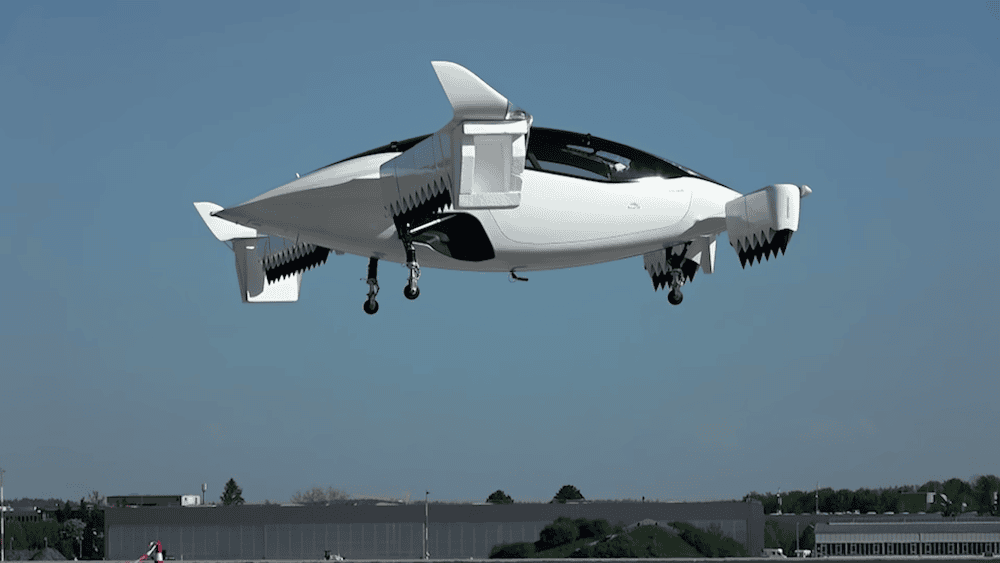
[Image above] Lilium GmbH, an air taxi startup, tests its Lilium Jet in early May. Unlike many flying cars currently in development that only allow one passenger and a pilot, Lilium’s vehicle has five seats. Credit: Lilium, YouTube
As I mentioned in a March article on manufacturing company Goodyear’s futuristic “tires as propellers” concept, most current flying car designs look more like mini personal helicopters than cars. Instead of wheels, these designs feature landing gear suitable for a vertical takeoff and land (VTOL) approach. The VTOL design is so ubiquitous that many news media outlets use the terms “flying cars” and “VTOLs” as synonyms!
Though these VTOL designs may not look like the one promised in Back to the Future, companies planning air taxi services in big cities prefer these designs to wheeled flying cars that require runways because VTOLs can more easily navigate in and out of tight spaces.
One reason VTOLs have gained so much attention recently is because of the purported benefit that flying cars offer a more sustainable mode of transport than land-based cars by reducing commute times. However, a recent open-access article in Nature Communications by University of Michigan and Ford Motor Company researchers highlights the fact that although VTOLs could reduce commute times, their sustainability is more questionable.
“Tilt-rotor/duct/wing VTOLs are efficient when cruising but consume substantial energy for takeoff and climb; hence, their burdens depend critically on trip distance,” the researchers write in the paper.
To determine what distance a VTOL must travel to become sustainable, the researchers simulated emissions from a single-passenger commute taken in a VTOL, a land-based gas-powered car, and a land-based electric car.
(Most flying car designs are electric and so, like electric cars, would not produce emissions directly. Instead, the researchers based emissions on the pollution associated with generating electricity needed to power these vehicles.)

Hidden emissions—much of the electricity that powers electric cars and many flying car designs is generated by traditional fossil fuel sources, which create “hidden emissions” for these vehicles. Credit: mariordo59, Flickr (CC BY-SA 2.0)
They found a regular gas-powered car produced fewer emissions than VTOLs in trips shorter than 22 miles (35 km), and VTOLs did not even come close to matching an electric car’s low emissions until a trip reached close to 74.5 miles (120 km).
However, these estimates were based on single-passenger commutes. When the researchers did their calculations assuming 1.54 passengers for the regular and electric cars (the US average) and three passengers for the VTOL (not including the pilot), they found the VTOL was 52% and 6% cleaner than the regular car and electric car, respectively, for a trip lasting about 60 miles (96.5 km).
The conclusion we can draw from this study appears relatively simple—to ensure flying cars are sustainable, create flying cars that can hold multiple passengers. Yet many companies currently planning air taxi services are developing flying cars with only two seats: one for the passenger, one for the pilot.
This two-seat design is not the case for air taxi startup Lilium GmbH. Their planned air taxi, the Lilium Jet, will seat up to four passengers!
According to a press release, the Lilium Jet has a top speed of 186 mph (300 kmh) and a range of 186 miles (300 km). Additionally, the lift generated by the fixed wing design of the aircraft will keep the aircraft in the air, so “it will require less than ten percent of its maximum 2,000 horsepower during cruise flight.”
The five-seater design builds on successful flight testing of a two-seater prototype in 2017, and Lilium tested the new five-seater jet for the first time on May 4, 2019. You can see that flight in the video below.
Though a commercial launch of this technology is still years in the future, the fact a company is considering multi-seat VTOLs is an important step toward sustainably integrating flying car technology into our society. But just like driverless cars, developing the technology is one thing—how would an air taxi system be regulated?
The open-access paper on VTOL sustainability, published in Nature Communications, is “Role of flying cars in sustainable mobility” (DOI: 10.1038/s41467-019-09426-0).

Credit: Lilium, YouTube
Author
Lisa McDonald
CTT Categories
- Aeronautics & Space
Spotlight Categories
- Member Highlights


